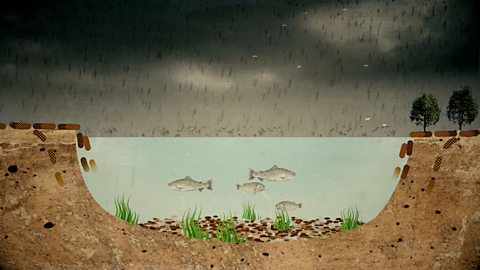Paul:
This stretch of the Wharfe in Ilkley looks idyllic, but all is not well beneath the surface. Like most of our rivers, it is in fact, under threat from pollution and the problem is that pollution isn't neon like in the films - it's pretty much invisible. So you've got to look deeper.
Hello, Mark.
Mark:
Afternoon, Paul.
Paul:
How are you doing?
Mark:
I'm all right. Good to see you.
Paul:
Ah, the timeless wonder of the English countryside.
Mark:
Yes!
Paul:
And that beautiful symphony, the rural back drop of, uh, sewage treatment works.
Mark:
England's green and pleasant land.
Paul:
Mark Barrow is on a mission to draw attention to the plight of our rivers, especially his beloved Wharfe, by actually diving in and filming down below.
It's a very beautiful river I have to say.
Mark:
Yes, yeah.
Paul:
But there are many problems with the Wharfe, aren't there?
Mark:
There's huge problems with the Wharfe. There's, literally underneath our feet are the two pipes from Ilkley sewage works.
Paul:
Now, Mark. You're- I don't know how to put this. Three words I thought of. Brave, intrepid,
Mark:
Yeah.
Paul:
stupid.
Mark:
I'll go with first two.
Paul:
I think it's a combination of all three. Yeah, cos you don't just get in and wade about and look for evidence of this. You actually you get in and get under.
Mark:
Yeah, it's not uncommon, if had sewage discharge is going on, for me to actually get in while that discharge is happening and I'll film the entire process underwater because you've got to see it to believe it. By the time I get out sometimes I can be literally covered in everything that's been flushed down the toilet.
Paul:
I mean you're quite fragrant now. But, uh, I might keep my distance when you come out.
Mark:
I would, yeah.
Paul:
It's through the actions of foolhardy people like Mark that the grim reality of what is happening to our rivers has been brought to the surface, especially when it comes to the activity of the water companies.
Mark:
There is nothing glamorous about this at all.
Paul:
Mark is literally putting his wellbeing at risk when he does this for the rivers that he loves. Untreated sewage can contain all kinds of bacterial nasties, from salmonella to E. coli.
Can I do anything?
Mark:
No.
Paul:
Good, thank you, that is the correct answer.
Mark:
I'll see you in about ten minutes.
Paul:
Go on, then. Oh, dear. I'll be here. Don't worry. Go on, on you go. All fine.
Crew:
Do you not fancy getting in, Paul?
Paul:
You wouldn't get me in there. Not in a million years. No chance. Anyway, I wouldn't want to upstage Mark, would I?
I mean, what could be more normal than watching a grown middle-aged man flounder around in some sewage? I think it could catch on.
Mark:
And there's plenty of sewage that's just down here.
Paul:
Is there?
Mark:
So, uh, I'll bag a few items up for you.
Paul:
(singing) "I like the way you work it. No diggity. You gon' bag it up.
What Mark is collecting are wet wipes and sanitary towels flushed down the toilet and released into the river. And they're just the bits you can see. It's all part of the great waste water treatment system which works a bit like this. It starts with us as we turn on our taps, fire up the washing machine or flush down the brown. That waste, then travels down pipes into the sewers and off to the treatment works. And then it's either sent off to be cleaned up for drinking water or pumped back into the rivers as treated effluent. With most of the nasties filtered out. But, when the system is under stress from heavy rainfall, the sewers become overwhelmed and therefore the water companies are allowed to release pressure on the system by diverting the flow of waste water and rainwater into the river through combined sewer overflow pipes or CSO. Which means that all kinds of nasties can end up being discharged directly into the waterway, Gentle Knight. What treasures have you got for me?
Mark:
Some of Yorkshire's finest.
Paul:
Oh dear. Oh, my God. I saw something move in there.
Mark:
And this is just five minutes spent on a river bed.
Paul:
Oh, my God.
Mark:
So we've got wipes which is the biggest instigator of sewage litter. But then…it is vile.
Paul:
Yeah.
Mark:
We've got sanitary towels. I mean just, it's shocking.
Paul:
It really is.
Mark:
A lot of people are still unaware that this going on. They're actually under the impression that their sewage is actually being treated properly.
Paul:
Yeah well I did, Mark. That's exactly what I thought happened. I thought, you know, the adult water companies treated the sewage and then discharged, you know, perhaps not drinking water quality water, but you know, water that's free of stuff like this responsibly.
Mark:
Yeah.
Paul:
And we all bear a personal responsibility as well.
Mark:
Yes
Paul:
There's no need for this stuff to go down the loo in the first place.
Mark:
This particular - I saw in 2021 discharge for over nine hundred hours. If you include all the little streams and tributaries, we were up thirteen thousand hours this coming through this river. Shocking.
Paul:
A beautiful river like this. It is a crime. Anyway, hats off to you, Mark. I'd help you out, but I don't really want to touch you.
Mark:Well, judging by the smell of these clothes it's probably a good idea actually, yeah.
Paul:
Untreated sewage can be discharged through CSO's under a permit given to water companies by the Environment Agency to help manage waste water. The rules are they should only release diluted sewage when treatment works are overwhelmed in wet conditions.
Paul Whitehouse visits The River Wharfe in Ilkley, West Yorkshire to see how it is affected by pollution from many sources.
The river begins at the confluence of Green Field Beck and Oughtershaw Beck in Langstrothdale. The Wharfe flows into the River Ouse after a journey of about 81 miles (130km) and forms the county boundary between West Yorkshire and North Yorkshire for much of its length. On its journey it passes through a variety of small villages, and larger settlements such as Kettlewell, Grassington, Addingham, Ilkley, Otley, Wetherby and Tadcaster. Like many rivers in the UK today, it is affected by pollution from many sources, one of which is human sewage.
Human activity generates wastewater every day. Domestic wastewater comes from our kitchens, bathrooms, toilets and sinks. Industry also produces a lot of wastewater. This wastewater contains sewage, chemicals and nutrients that are harmful to animals and plants, so it needs to be treated before it is returned to the environment.
Our wastewater travels down pipes to sewers, then to treatment plants where it is cleaned and filtered for drinking water or returned to our rivers as treated effluent. However, when sewers come under stress from heavy rainfall, water companies are allowed to relieve pressure by releasing wastewater and rainwater directly into rivers through Combined Sewer Overflow pipes, commonly known as CSOs. This is a direct cause of pollution affecting UK rivers.
This video is part of UK rivers case studies, a series of clips taken from Paul Whitehouse: Our Troubled Rivers – available on BBC iPlayer.
Please note that in this clip a contributor is seen diving into a polluted river to look for evidence of sewage discharge. As Paul Whitehouse says in the video, this activity could put your wellbeing at risk and students should be reminded not to try this at home.
Teacher Notes
Before watching the film:
- Ask students what they know about river pollution. Can they name different kinds of pollution that might be found in rivers and identify where it has come from? Ask students if they think human sewage is a big problem in UK rivers and why.
- You might also ask students what happens to our wastewater from domestic sources and find out what they know about sewage treatment plants.
- The film contains some technical vocabulary so you might want to ensure students have a familiarity with the following words and terms, perhaps by creating a glossary.
- Combined Sewage Overflow pipes (CSO)
- Effluent
- Environment Agency
- Sewage
- Sewer
- Storm drain
- Wastewater
- Water Company
During the film:
- You may wish to stop at relevant points during this short film to pose questions and check understanding or wait until the end. Useful questions might include:
- What happens to the sewer system when we get heavy rain?
- What are the other factors that increase stress on the wastewater treatment system? (Increased incidence of extreme rainfall due to climate change, growing size of settlements).
- What can we do in our own lives to limit wastewater debris? (An example might be to dispose of items such as wet wipes by disposing of them properly, rather than flushing them into the drains).
Following on from the film:
- Discuss how students feel after seeing the film and ask them what percentage of rivers in England they think may be affected. Research river pollution from sewage using news sources and government reports in an effort to establish some facts about the scale of the problem.
- An Ordnance Survey report in 2023 lists the following:
Figures from the Environment Agency (EA), one of the UK's water regulators, show there were more than 770,000 raw sewage discharges into the ocean and rivers around the UK over the course of 2020 and 2021 – the equivalent of almost 6 million hours.- Use the interactive map from the Rivers Trust to investigate your own local river.
- Students could draw a diagram explaining the cycle of water treatment using appropriate terminology and identifying weak points in the system.
- Ask students to explain why rivers, and the wildlife they support matter, giving examples, and identifying problems caused by discharging untreated effluent back into rivers. This work could be developed into a case study of river pollution, identifying causes, impacts and suggesting possible strategies for improvement.
- Plan for fieldwork to locate and investigate local CSOs and consider safe ways to assess local water quality.
- Thinking globally, students could go on to investigate the role of GIS in identifying sewage spills in the UK and beyond.
Related Links:
- BBC
- Other
Curriculum Notes
All these short clips build on students’ understanding of human and environmental interactions and provide opportunities to practice geographical skills such as enquiry, mapping and fieldwork.
At KS3, students can learn more about how human and physical processes interact to influence, and change landscapes, environments and the climate.
At KS4, the film supports understanding about fluvial environments, environmental management and fieldwork investigation.
This clip could be used to support the delivery of geography to KS3 and KS4 students.
Specifically, this topic appears in OCR, Edexcel, AQA KS4/GCSE in England, WJEC Progression Step 4/5 in Wales, CCEA GCSE in Northern Ireland and SQA S4/5 in Scotland.
The film might be used for example, to contribute to case studies about human interactions on fluvial environments (CCEA), or about environmental challenges (WJEC).
Further clips from Paul Whitehouse: Our Troubled Rivers
Water industry privatisation. video
A look at the background to the privatisation of ten regional water authorities in 1989.

Lake Windermere eutrophication. video
Paul visits Lake Windermere to hear how tourists may be contributing to pollution levels.
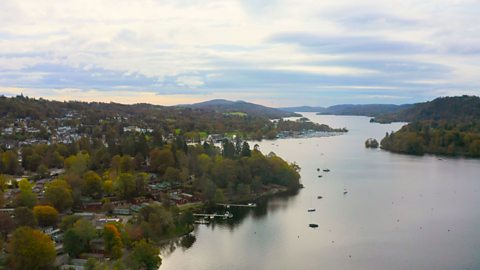
Beavers and rewilding in the UK video
Paul visits the River Tamar in Devon to hear about a project that aims to let nature restore ecosystems.

Pharmaceutical pollution in the River Clyde video
Paul visits the River Clyde in Glasgow to hear about pharmaceutical pollution and its consequences.
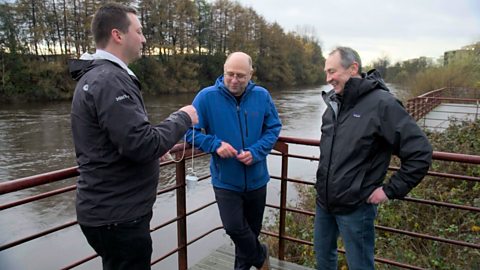
River monitoring and 're-wiggling' on the River Ribble. video
Paul visits the River Ribble in Lancashire to look at biodiversity monitoring and a project that is putting meanders back into the river.
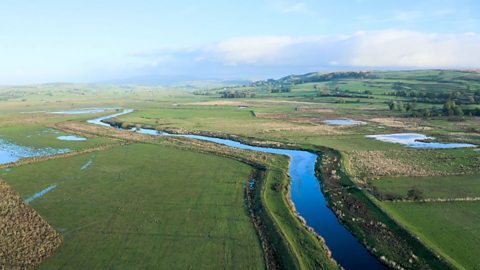
River Tame microplastic pollution. video
Paul learns about how microplastic pollution affects the River Tame in Greater Manchester.
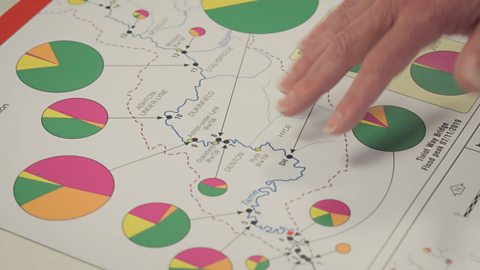
River Test and UK chalk streams. video
Paul visits Hampshire to look at a very rare habitat – England contains 85% of all chalk streams in the world.

River Thames Tideway project video
Paul visits the construction site of a 'super sewer' in London.
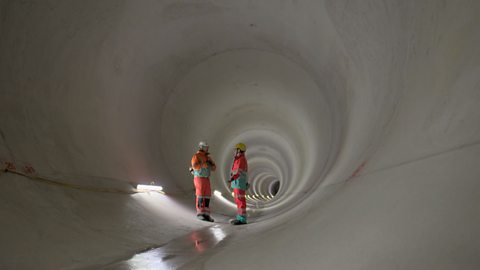
Intensive chicken farming and the River Wye video
Paul looks at how agricultural pollution is affecting the River Wye.
